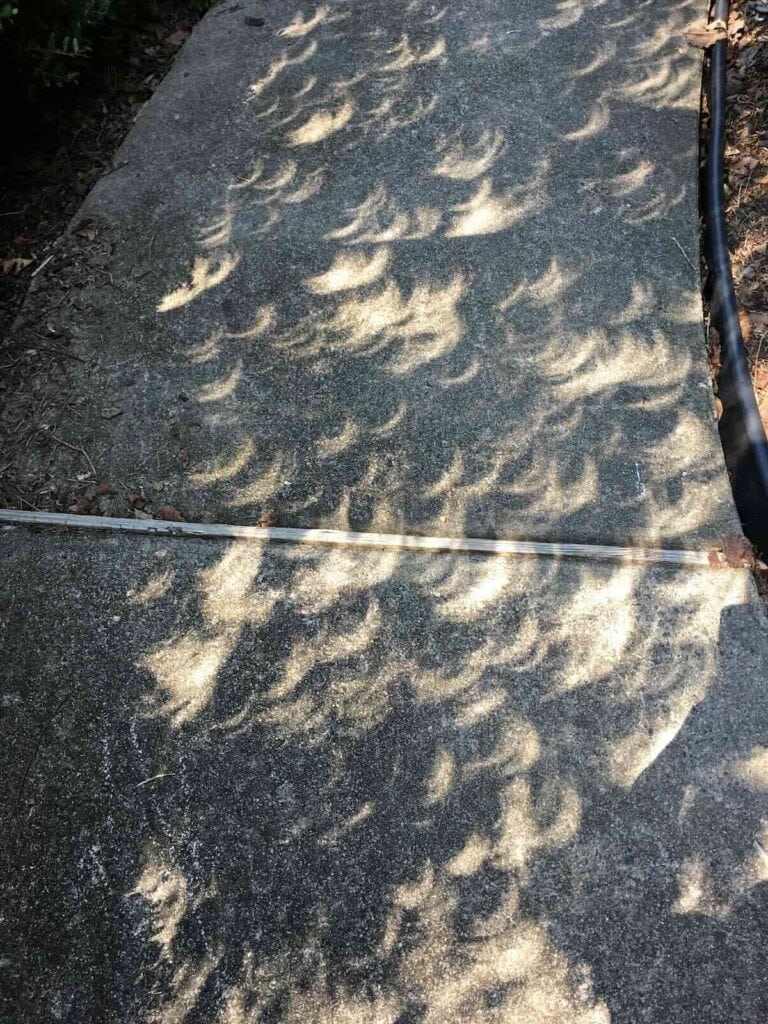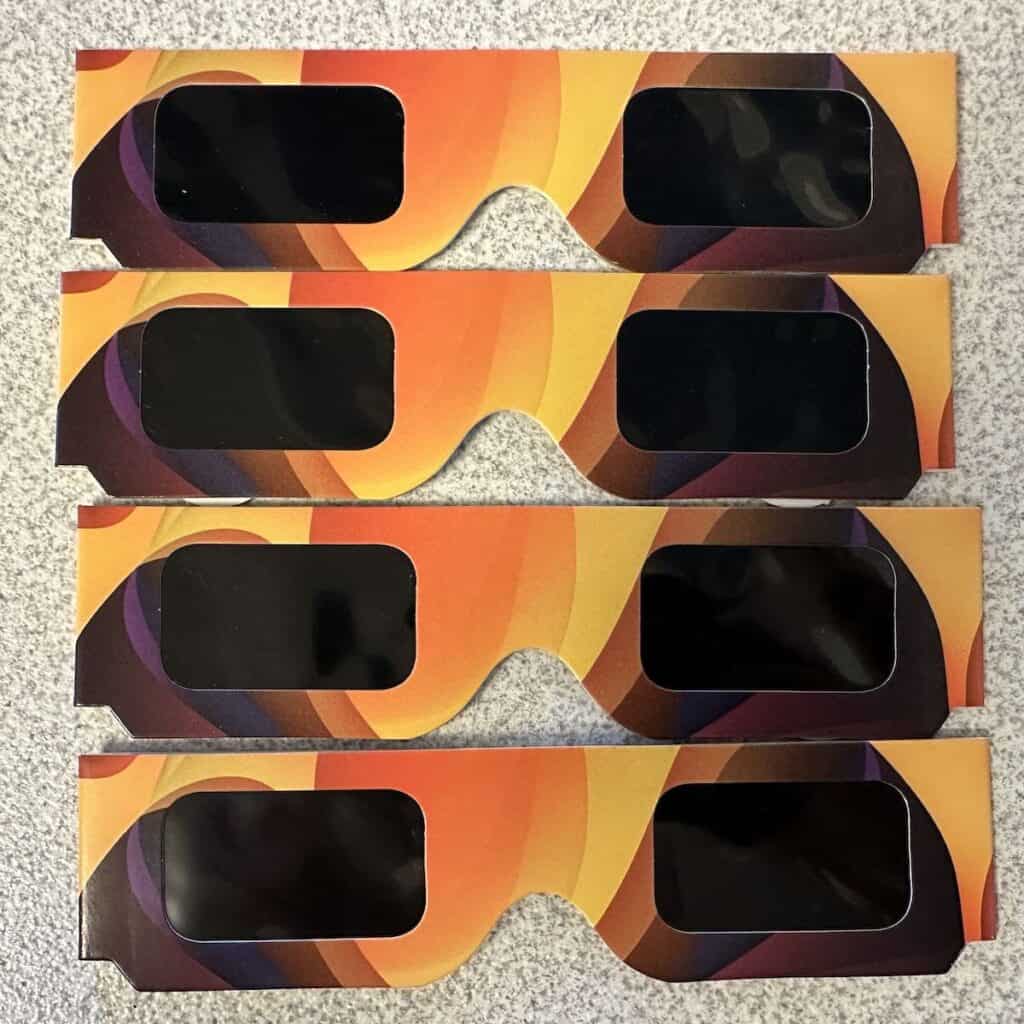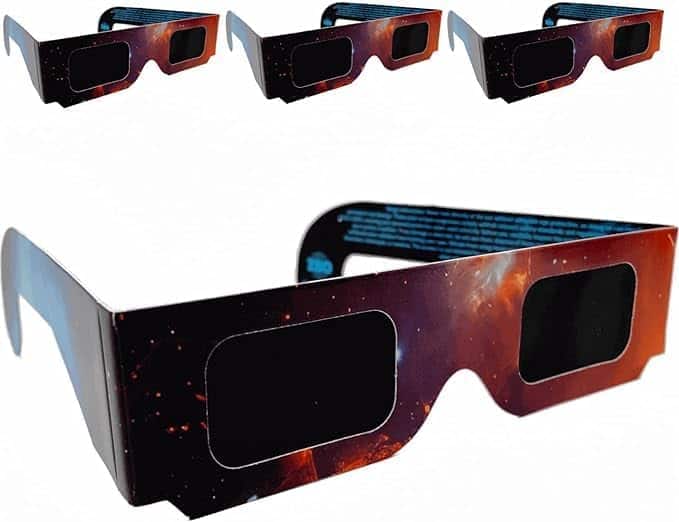On April 8, 2024, a rare solar eclipse will occur across all U.S. states (excluding Alaska and Hawaii). A total of 13 states will witness a “total solar eclipse.” In a total eclipse, the moon blocks 100% of the sun for a few minutes, creating a ring-like aura from the sun’s outer atmosphere and a darkened sky similar to twilight.
The remaining states (including North Carolina) will experience a partial eclipse. As the name suggests, the Moon will only obscure (or “bite”) a portion of the sun rather than the full 100%.
North Carolina’s partial eclipse will see the sun obscured anywhere from around 70% in the coastal regions to 85% in the mountains, which will be worth watching. Read on to learn what to expect from the partial eclipse in your area.
When will the 2024 Solar Eclipse happen in the Triangle?
The Triangle can expect the partial eclipse to last 2 hours and 30 minutes, starting roughly at 1:57 p.m. and ending at 4:30 p.m. At peak, the Sun will be about 80% obscured. Peak will happen around 3:15 p.m., but it’s suggested you view the exact time for your location on this interactive map.
What will the Solar Eclipse look like in the Triangle?

With 80% of the Sun covered, onlookers may notice some interesting phenomena:
- Sun’s Appearance: Viewed with solar eclipse glasses or a filtered lens, the Sun will look like a narrow crescent.
- Atmospheric Changes: The sky will grow notably dimmer. Colors may look greyer as if a cloud is passing overhead.
- Temperature Effects: Temperatures may drop, influencing wind and humidity patterns.
- Shadow Transformation: Shadows will become sharper.
- Unique Light Patterns: Crescent-shaped lights can be observed among shadows cast by tree leaves or can be created with tools such as colanders. These shapes are a projection of the eclipse’s current phase caused by concentrated pin-holes of sunlight.
Best place in the Triangle to see the Solar Eclipse
Any spot not obstructed by trees or buildings will be a good spot to watch the partial solar eclipse in the Triangle on April 8, 2024. You don’t need to worry about finding a spot free of light pollution like you need to for night-time stargazing.
The main factor that can ruin eclipse-viewing is cloudy weather.
The Triangle: April 2024 Solar Eclipse vs. Previous Years
The Triangle’s encounter with this upcoming solar eclipse will differ from the ones in August 2017 and October 2023. It will be less pronounced than 2017’s partial solar eclipse, which achieved up to 93% totality in the area and lasted for 2 hours and 50 minutes. But this eclipse will be far more noticeable than 2023’s annular solar eclipse, which was only 38% obscuration at peak.
How can you safely observe the Solar Eclipse?

Though the majority of the sun will be covered, viewing the eclipse without the proper eye protection can cause permanent eye damage. To be safe, use solar viewing glasses (aka, eclipse glasses).
If you don’t have solar eclipse glasses you can easily make a solar eclipse pinhole viewer to watch the eclipse indirectly.
Regular sunglasses will not be enough to protect the eye. If you have an old pair of eclipse glasses, inspect them for damage to the lenses before use. NASA doesn’t approve of any specific brands of eclipse glasses, so check the authenticity of any eclipse glasses before purchasing. Look for ones that are compliant with the ISO 12312-2 safety standard.
Both plastic and paper frames are available.
Tember Solar Eclipse Glasses

Tember Solar Eclipse Glasses: This 4-pack of solar eclipse glasses is tested according to ISO 12312-2, validated by POCA laboratories, and is very reasonably priced. Check price here.
More Solar Eclipse Glasses
No products found.
No products found.
- 【SAFE TO USE】Our solar eclipse glasses are independently tested and verified by ICS laboratories according to the latest standard ISO 12312-2:2015(E), compliant with international standards….
- 【HIGH QUALITY FILTER】Our solar eclipse glasses are equipped with high quality filters that can filter out 100% of harmful light (such as UV/IR) and 99.999% of strong visible light. The filter…
- 【2024 TOTAL SOLAR ECLIPSE】On April 8, 2024, the total solar eclipse will enter the U.S. from Texas, and a partial solar eclipse will be observed throughout the United States on that day. The next…
- Solar eclipse glasses Approved 2024, Safe Solar Observation – These certified safe shades are designed for direct solar viewing. Our solar eclipse glasses are perfect for observing eclipses, sunspots,…
- Meets Industry Standards – Our CE and ISO certified safe shades for direct sun viewing are made while adhering to stringent safety and quality regulations set by the American Astronomical Society.
- A Comfy Fit – These certified sunglasses for eclipse are suitable for teens and adults. Featuring crease lines on both sides, these optical quality safe shades may be worn over prescription glasses.
No products found.
When viewing the eclipse through a lens (camera, binoculars, telescope, etc.), you should not rely on eclipse glasses. Lenses will concentrate sunlight into a more powerful form that is too strong for eclipse glasses. Instead, you can look into buying solar filters for your optical device. With these filters applied, you can safely look through the lenses without eclipse glasses.
Click here to read NASA’s article on eclipse-viewing safety.
Solar Eclipse Events in the Triangle
Follow each link for information on these events.
Seeing the Total Solar Eclipse
Those traveling to see the total solar eclipse rather than the partial one should plan accordingly. As the eclipse grows closer, keep an eye on the weather and try to avoid cloudy areas. Anticipate heightened traffic from fellow travelers, and be aware that bookings for airfare, accommodations, and similar services may fill up quickly.
In sequence, the states in the totality path are as follows: Texas, Oklahoma, Arkansas, Missouri, Kentucky, Illinois, Indiana, Ohio, Pennsylvania, New York, Vermont, New Hampshire, and Maine.
Click here to read predictions about high-traffic areas during the eclipse.
Are you traveling to the path of totality? Here’s some information on the solar eclipse in Maine, and here’s a guide to the solar eclipse in Ohio.
Future Total Eclipses
After the 2024 solar eclipse, there won’t be another total solar eclipse viewable from the contiguous United States until August 23, 2044.
If you’re able to travel internationally, you won’t have to wait so long. Here are some upcoming total solar eclipses:
- August 12, 2026: Arctic, Greenland, Iceland, Spain
- August 2, 2027: Morocco, Spain, Algeria, Libya, Egypt, Saudi Arabia, Yemen, Somalia
- July 22, 2028: Australia, New Zealand
- November 25, 2030: Botswana, South Africa, Australia
- March 30, 2033: Russia, Alaska
- March 20, 2034: Nigeria, Cameroon, Chad, Sudan, Egypt, Saudi Arabia, Iran, Afghanistan, Pakistan, India, China
- September 2, 2035: China, North Korea, Japan, Pacific Ocean
- July 13, 2037: Australia, New Zealand
- December 26, 2038: Australia, New Zealand, South Pacific
- December 15, 2039: Antarctica



